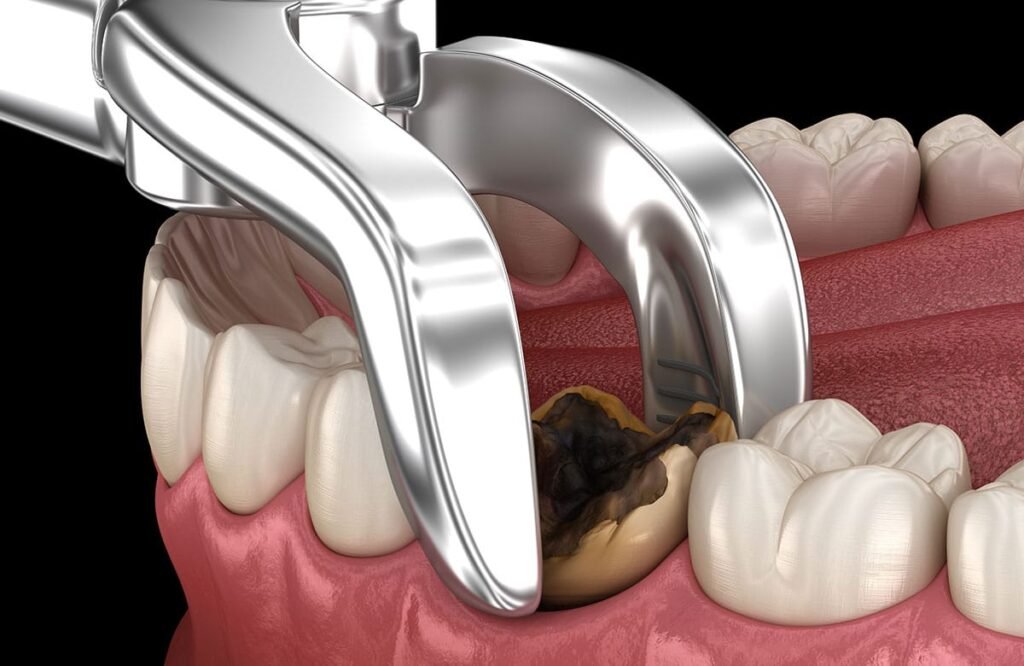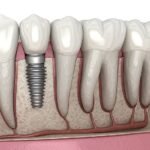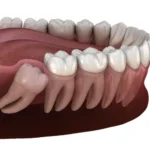
Regarding dental procedures, tooth extraction is one of the most common yet misunderstood treatments. Despite the advancements in dental care, there are situations when extracting a tooth becomes necessary for overall oral health. At Urban Smile Dental Clinic, we prioritize patient comfort and well-being, making the tooth extraction as seamless as possible. This blog will explore tooth extraction, why it’s needed, how it’s performed, and how to care for yourself afterwards.

What is Tooth Extraction?
Tooth extraction is the process of removing a tooth from its socket in the bone. While permanent teeth are meant to last a lifetime, several factors may necessitate their removal. The procedure can be straightforward or complex, depending on the tooth’s condition, location, and the patient’s oral health.
Tooth extraction falls into two categories:
- Simple Extraction: This involves removing a tooth that is visible in the mouth. It is usually done with local anaesthesia and is relatively quick and painless.
- Surgical Extraction: This is a more complex procedure, often required for impacted teeth, teeth that have broken off at the gum line, or teeth that haven’t fully erupted (like some wisdom teeth). It is performed by an oral surgeon and might involve sedation.
Why is Tooth Extraction Needed?
There are various reasons why a tooth may need to be extracted, ranging from decay and trauma to orthodontic requirements. Let’s delve into some of the most common reasons:
- Severe Tooth Decay or Infection: When tooth decay reaches the pulp (the centre of the tooth), bacteria can enter the pulp and cause an infection. Often, this can be treated with root canal therapy. However, if the infection is severe and cannot be treated, extraction may be required to prevent the infection from spreading to other areas of the mouth or body.
- Periodontal Disease: Gum disease can cause the loosening of teeth as it damages the gums and the bone supporting the teeth. In advanced stages, the affected teeth may need to be extracted.
- Impacted Wisdom Teeth: Wisdom teeth, or third molars, often do not have enough room to erupt properly. They can become impacted (trapped in the jawbone), leading to pain, infection, or damage to adjacent teeth. In such cases, extraction is necessary.
- Overcrowding: In orthodontic cases, teeth may be removed to create space in the mouth and achieve better alignment of the remaining teeth.
- Trauma or Injury: In some cases, a tooth may be damaged beyond repair due to an accident or injury, requiring extraction.
- Fractured Teeth: If a tooth has broken down to a level that cannot be restored with dental procedures like fillings, crowns, or veneers, extraction may be the only option.
The Tooth Extraction Procedure: What to Expect
At Urban Smile Dental Clinic, we ensure that our patients are fully informed and comfortable throughout the procedure. Here’s how the process works:
- Preparation:
- Consultation: Before the procedure, you will have a thorough consultation with our dentist. We will review your medical history, take X-rays, and discuss any medications you may be on.
- Anaesthesia: Local anaesthesia will be administered to numb the area around the tooth. For complex extractions or anxious patients, sedation options such as nitrous oxide (laughing gas) or intravenous sedation may be considered.
- Extraction:
- For simple extractions, the dentist will loosen the tooth using an instrument called an elevator and then remove it with forceps.
- For surgical extractions, the dentist may need to make an incision in the gum to access the tooth. In some cases, the tooth may need to be divided into pieces for easier removal.
- Aftercare:
- Once the tooth is removed, a blood clot will form in the socket. The dentist will pack a gauze pad in the socket and have you bite down on it to stop bleeding.
- In some cases, the dentist may place a few stitches to help the gum tissue heal.
Recovery and Aftercare Tips
Post-extraction care is crucial for proper healing and to prevent complications such as dry sockets or infections. Here are some essential aftercare steps:
- Control Bleeding: Keep the gauze pad in place for at least 30-45 minutes after the extraction. If bleeding persists, replace the gauze and continue applying gentle pressure.
- Manage Pain: Once the anaesthesia wears off, you may experience some discomfort. Over-the-counter pain relievers like ibuprofen or acetaminophen can help. For more severe pain, the dentist may prescribe stronger medications.
- Reduce Swelling: Swelling is a common response after extraction. Applying an ice pack to the affected area for 10 minutes at a time can reduce swelling and provide comfort.
- Maintain a Soft Diet: For the first 24 hours, stick to a soft food diet that includes items like yoghurt, soup, or mashed potatoes. Avoid hot, spicy, or crunchy foods that can irritate the extraction site.
- Keep it Clean:
- Do not rinse your mouth vigorously for 24 hours to avoid dislodging the blood clot.
- After the first day, rinse gently with warm salt water (1/2 teaspoon of salt in a cup of water) several times a day, especially after meals.
- Avoid Smoking and Alcohol: Smoking and alcohol can interfere with the healing process and increase the risk of complications. Refrain from these activities for at least 48 hours after the procedure.
- Follow-Up Appointments: Be sure to attend any follow-up appointments to ensure the site is healing properly. The dentist will also check for any signs of infection or complications.
Frequently Asked Questions About Tooth Extraction
1. Is tooth extraction painful?
With proper anaesthesia, tooth extraction is typically painless. You may feel pressure, but there should be no pain during the procedure. Post-procedure pain can be managed with medication.
2. How long does it take to heal after tooth extraction?
Initial healing usually takes about 1-2 weeks, but it may take a few months for the extraction site to completely close and the bone to heal.
3. What is a dry socket, and how can I prevent it?
A dry socket occurs when the blood clot at the extraction site becomes dislodged, exposing the bone and nerves. It can be very painful and may delay healing. To prevent dry sockets, avoid using a straw, smoking, or rinsing your mouth vigorously during the first few days after extraction.
Conclusion
Tooth extraction is a straightforward procedure that can resolve many oral health issues, from severe decay to crowding. At Urban Smile Dental Clinic, we ensure that every patient receives compassionate, expert care before, during, and after extraction. If you think you may need a tooth extraction, don’t hesitate to schedule an appointment with us. Your comfort and oral health are our top priorities.


